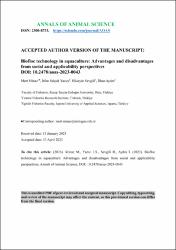| dc.contributor.author | Minaz, Mert | |
| dc.contributor.author | Yazıcı, İrfan Selçuk | |
| dc.contributor.author | Sevgili, Hüseyin | |
| dc.contributor.author | Aydın, İlhan | |
| dc.date.accessioned | 2023-08-18T08:31:30Z | |
| dc.date.available | 2023-08-18T08:31:30Z | |
| dc.date.issued | 2023 | en_US |
| dc.identifier.citation | Minaz,M.,Yazıcı,İ.,Sevgili,H. & Aydın,İ.(3923).Biofloc technology in aquaculture: Advantages and disadvantages from social and applicability perspectives. Annals of Animal Science,0(0) -. https://doi.org/10.2478/aoas-2023-0043 | en_US |
| dc.identifier.issn | 1642-3402 | |
| dc.identifier.issn | 2300-8733 | |
| dc.identifier.uri | https://doi.org/10.2478/aoas-2023-0043 | |
| dc.identifier.uri | https://hdl.handle.net/11436/8067 | |
| dc.description.abstract | The world aquaculture industry seeks sustainable production strategies to respond to the needs of the growing world population for valuable food. Biofloc technology (BFT) is accepted as a novel sustainable method that reduces the pollution load on receiving water resources with its zero-water-discharge approach, eliminates extra water treatment costs with its biological cycles, and supports the growth performance of reared animals and thereby reduces feed costs. However, each BFT system has its own set of difficulties and obstacles. This review focuses on the advantages and disadvantages of BFT systems in terms of economy, sociability and applicability. The BFT shows more effective results in the conversion of toxic nitrogenous compounds to nontoxic compounds compared with the technologies based on nitrification processes. In addition, the growth performance and health of the cultured animals are generally better in BFT systems than those in conventional rearing systems (continuous water flow). The risk of common diseases occurrence due to pathogenic microorganisms appears to be lower in BFT systems compared to conventional aquaculture. It is also noteworthy that the immune system, biochemical stress indicators and antioxidant activities of organisms held in BFT systems are positively affected. In BFT systems based on microbial activity, the high water temperature demanded by bacteria is a limiter for the system. Moreover, a higher aeration/energy requirement is the case in BFT to meet the oxygen demand of all organisms including fish, shrimp, heterotrophic bacteria, nematodes, rotifers and others inside. There is also another concern about the acceptability potential of the cultured organism in BFT systems for consumption. Finally, since the high temperature demand of the system will create high energy costs, it should be considered as another restriction that forces the application. Considering the advantages and disadvantages of BFT systems as sustainable aquaculture, this review provides a guide for future studies and full-scale implementations. | en_US |
| dc.language.iso | eng | en_US |
| dc.publisher | Walter de Gruyter | en_US |
| dc.rights | info:eu-repo/semantics/openAccess | en_US |
| dc.subject | Biofloc | en_US |
| dc.subject | Sustainable aquaculture | en_US |
| dc.subject | Organic waste | en_US |
| dc.subject | Fish | en_US |
| dc.title | Biofloc technology in aquaculture: Advantages and disadvantages from social and applicability perspectives | en_US |
| dc.type | article | en_US |
| dc.contributor.department | RTEÜ, Su Ürünleri Fakültesi, Su Ürünleri Yetiştiriciliği Bölümü | en_US |
| dc.contributor.institutionauthor | Minaz, Mert | |
| dc.identifier.doi | 10.2478/aoas-2023-0043 | en_US |
| dc.relation.journal | Annals of Animal Science | en_US |
| dc.relation.publicationcategory | Makale - Uluslararası Hakemli Dergi - Kurum Öğretim Elemanı | en_US |


















